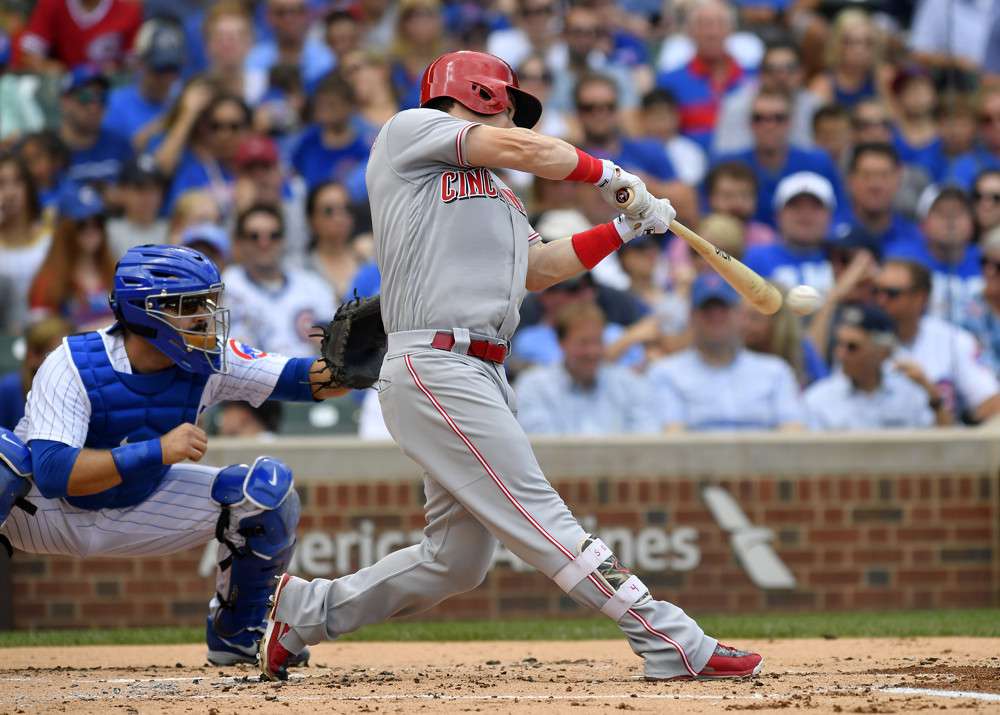
With the 2017 regular season now officially in the rearview mirror, we turn our attention to the 2018 fantasy baseball season. Each week, I will be evaluating one player’s stock for next year. This week, we focus on Scooter Gennett, arguably the 2017 season’s most successful waiver claim.
Scooter Gennett, Cincinnati Reds
2017 statistics: .295/.342/.531, 27 home runs, 3 stolen bases
Another player whose power output was exponentially improved the season, Gennett launched 27 home runs in a stellar offensive season in Cincinnati after he was claimed off of waivers from Milwaukee during Spring Training. His breakout season included a four-homer game in arguably baseball’s most shocking single-game performance of the year. Gennett’s .295/.342/.531 line this year was comfortably above-average, even in the hitter-friendly confines of Great American Ball Park. He also made some significant underlying changes to his profile to support that improvement, positioning him fairly well for next season.
Batted-Ball Profile
When looking at Gennett’s profile, the most notable peripheral statistic is his spike in batted-ball authority this year. After running average exit velocities on balls hit into the air of 87.3 MPH in both 2015 and 2016, Gennett’s average air-ball exit velocity spiked to 90.7 MPH this season, with his hard-contact rates increasing from 22.1% to 28.9% to 34.4%. That increase in contact authority is the result of him becoming increasingly more pull-happy, while his 1.1 GB:FB ratio in 2017 was the lowest in any full season of his career. The confluence of these factors, along with the league-wide increase in home runs, largely explain Gennett’s improved power output, as well-hit fly balls to the pull-side are the most likely balls to clear the fences.
This wasn’t simply a fleeting hot streak, either. While much of Gennett’s improvement in hard contact rate came in the first half, he continued to lift and pull throughout the entire season. Gennett has not given any public indication of a change-in-process. However, the underlying numbers have supported his power breakout to some extent, potentially indicating an effort on the player’s part to increase his slugging output. Most encouraging, however, is that Gennett seemingly managed to pull off this change in approach without sacrificing anything in the way of contact. Gennett’s contact and strikeout rates this year were largely in line with his career averages. While he still has below-average plate discipline, his bat-to-ball skills are solid enough to allow him to keep his strikeout rate right around the league-average.
Versatility
Another factor paradoxically working in Gennett’s favor, from a fantasy perspective, is the fact that his defense at second base was poor yet again this year. This caused Cincinnati to give him some playing time in the corner outfield. Accordingly, Gennett picked up dual positional eligibility for next season in some leagues, so owners could take a flyer on him as a reserve option at second base with plans to use him in the outfield or vice versa.
Of course, that versatility would be less important if Gennett has truly established himself as a top-five fantasy option at second base, but it would certainly not be crazy to doubt the sustainability of Gennett’s current performance. For example, even after accounting for the increase in solid contact, Gennett’s expected weighted on-base average this year (a metric estimating a player’s production based on his strikeouts, walks and exit velocities and launch angles) sat at a lackluster .312, well below his actual .367 mark. Expected batting average, which uses the same metrics, also viewed Gennett’s performance this season as quite fortunate, estimating that he “should have” hit .247, not anywhere near his actual .295 batting average.
Home Park
These batted-ball metrics, however, do not adjust for home park, so Gennett’s playing in Cincinnati’s hitter-friendly confines means that his expected future production likely lies somewhere in between his actual results this season and his expected results. Given Cincinnati’s status as a rebuilding club who struck gold on a 27-year-old waiver claim, Gennett could speculatively be shopped this offseason to contenders needing second base help. That said, a trade could offset the loss of the favorable home park by placing him on a more formidable offensive team to provide him more runs scored and RBI opportunities. (Cincinnati ranked 14th in runs and 10th in OPS this year, a fine but unspectacular offensive club.)
2018 Fantasy Value
Without much speed to speak of (he stole only three bases this season), Gennett needs to maintain his offensive gains, particularly in the power department, if he is to remain relevant for fantasy purposes. Fortunately, there are reasons to believe that the 27 home runs of this season are closer to the future norm than the 9-14 homers per year that Gennett was hitting as a Brewer. However, expecting him to maintain a .339 BABIP is likely too optimistic. And his batted ball authority indicates that he remains a clear tier below the league’s second tier of second basemen, making his outfield eligibility quite significant for fantasy purposes. Because of the uptick in fly balls and hard contact this season, though, Gennett’s stock is trending upward, and he likely profiles as a mid-tier regular option at second base in 2018.
